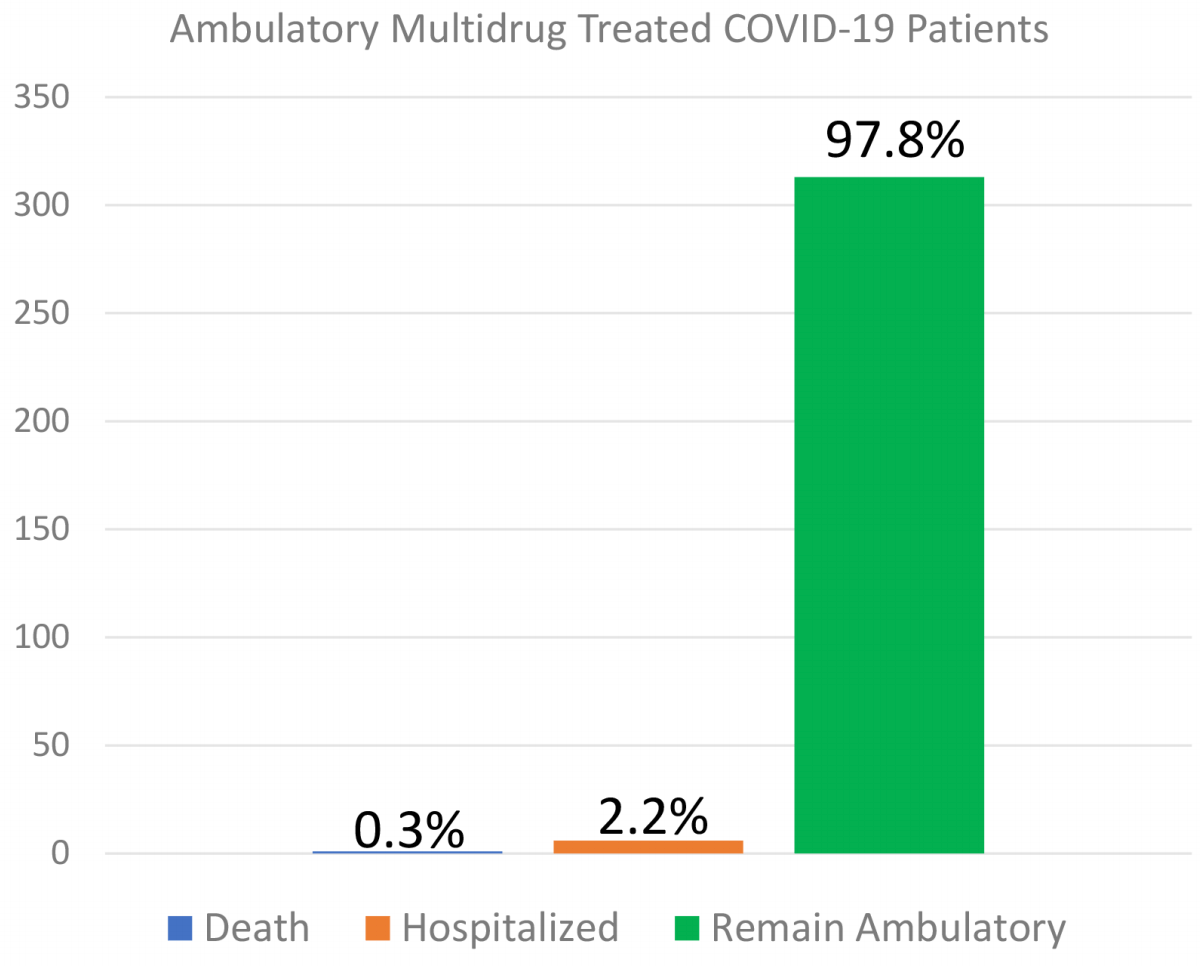Clinical outcomes after early ambulatory multidrug therapy for high-risk SARS-CoV-2 (COVID-19) infection
Brian C Procter, Casey Ross, Vanessa Pickard, Erica Smith, Cortney Hanson, Peter A Mccullough
Reviews in Cardiovascular Medicine, doi:10.31083/j.rcm.2020.04.260
There is an emergency need for early ambulatory treatment of Coronavirus Disease 2019 in acutely ill patients in an attempt to reduce disease progression and the risks of hospitalization and death. Such management should be applied in high-risk patients age > 50 years or with one or more medical problems including cardiovascular disease. We evaluated a total of 922 outpatients from March to September 2020. All patients underwent contemporary real-time polymerase chain reaction (PCR) assay tests from anterior nasal swab samples. Patients age 50.5 ± 13.7 years (range 12 to 89), 61.6% women, at moderate or high risk for COVID-19 received empiric management via telemedicine. At least two agents with antiviral activity against SARS-CoV-2 (zinc, hydroxychloroquine, ivermectin) and one antibiotic (azithromycin, doxycycline, ceftriaxone) were used along with inhaled budesonide and/or intramuscular dexamethasone consistent with the emergent science on early COVID-19 treatment. For patients with high severity of symptoms, urgent in-clinic administration of albuterol nebulizer, inhaled budesonide, and intravenous volume expansion with supplemental parenteral thiamine 500 mg, magnesium sulfate 4 grams, folic acid 1 gram, vitamin B12 1 mg. A total of 320/922 (34.7%) were treated resulting in 6/320 (1.9%) and 1/320 (0.3%) patients that were hospitalized and died, respectively. We conclude that early ambulatory (not hospitalized, treated at home), multidrug therapy is safe, feasible, and associated with low rates of hospitalization and death. Early treatment should be considered for high-risk patients as an emergency measure while we await randomized trials and guidelines for ambulatory management.
Authors' contributions BCP, CR, VP, ES, CH, contributed patient data, PAM drafted the first version, and all authors contributed edits to the final version.
Ethics approval and consent to participate All patients provided informed consent for treatment according to good clinical practice.
Conflict of interest Nothing to disclose. Authors had access to the data and wrote the manuscript.
References
Cervino, Oteri, COVID-19 pandemic and telephone triage before attending medical office: problem or opportunity?, Medicina (Kaunas)
Derwand, Scholz, Zelenko, COVID-19 outpatients: early risk-stratified treatment with zinc plus low-dose hydroxychloroquine and azithromycin: a retrospective case series study, International Journal of Antimicrobial Agents
Fiorillo, Cervino, Matarese, D'amico, Surace et al., COVID-19 surface persistence: a recent data summary and its importance for medical and dental settings, International Journal of Environmental Research and Public Health
Flannery, Adkins, Cook, Unpeeling the Evidence for the Banana Bag: Evidence-Based Recommendations for the Management of Alcohol-Associated Vitamin and Electrolyte Deficiencies in the ICU, Critical Care Medicine
Gambardella, Pagliuca, Pomilla, Gambardella, COVID-19 risk contagion: organization and procedures in a South Italy geriatric oncology ward, Journal of Geriatric Oncology
Lo, Bhargav, Salacup, Pelayo, Albano et al., Angiotensin converting enzyme inhibitors and angiotensin II receptor blockers and outcomes in patients with COVID-19: a systematic review and meta-analysis, Expert Review of Cardiovascular Therapy
Lo, Mccullough, Rangaswami, Antihypertensive drugs and risk of COVID-19?, The Lancet Respiratory Medicine
Mccullough, Eidt, Rangaswami, Lerma, Tumlin et al., Urgent need for individual mobile phone and institutional reporting of at home, hospitalized, and intensive care unit cases of SARS-CoV-2 (COVID-19) infection, Reviews in Cardiovascular Medicine
Mccullough, Kelly, Ruocco, Lerma, Tumlin et al., Pathophysiological basis and rationale for early outpatient treatment of SARS-CoV-2 (COVID-19) infection, The American Journal of Medicine
Palazzuoli, Mancone, De Ferrari, Forleo, Secco et al., Antecedent administration of angiotensin-converting enzyme inhibitors or angiotensin II receptor antagonists and survival after hospitalization for COVID-19 syndrome, Journal of the American Heart Association
Palazzuoli, Ruberto, De Ferrari, Forleo, Secco et al., Inpatient mortality according to level of respiratory support received for severe acute respiratory syndrome coronavirus 2 (coronavirus disease 2019) infection: a prospective multicenter study, Critical Care Explorations
Tolone, Gambardella, Brusciano, Del Genio, Lucido et al., Telephonic triage before surgical ward admission and telemedicine during COVID-19 outbreak in Italy. Effective and easy procedures to reduce in-hospital positivity, International Journal of Surgery
Vahidy, Drews, Masud, Schwartz, Askary et al., Characteristics and outcomes of COVID-19 patients during initial peak and resurgence in the Houston metropolitan area, Journal of the American Medical Association
Woloshin, Patel, Kesselheim, False negative tests for SARS-CoV-2 infection -challenges and implications, New England Journal of Medicine
Worldometer, COVID-19 Coronavirus Pandemic
Zhang, Mccullough, Tecson, Vitamin D deficiency in association with endothelial dysfunction: Implications for patients with COVID-19, Reviews in Cardiovascular Medicine
DOI record:
{
"DOI": "10.31083/j.rcm.2020.04.260",
"ISSN": [
"2153-8174"
],
"URL": "http://dx.doi.org/10.31083/j.rcm.2020.04.260",
"container-title": "Reviews in Cardiovascular Medicine",
"container-title-short": "Reviews in Cardiovascular Medicine",
"content-domain": {
"crossmark-restriction": false,
"domain": []
},
"created": {
"date-parts": [
[
2020,
12,
30
]
],
"date-time": "2020-12-30T09:45:31Z",
"timestamp": 1609321531000
},
"deposited": {
"date-parts": [
[
2022,
1,
31
]
],
"date-time": "2022-01-31T19:48:42Z",
"timestamp": 1643658522000
},
"indexed": {
"date-parts": [
[
2024,
5,
2
]
],
"date-time": "2024-05-02T00:06:27Z",
"timestamp": 1714608387288
},
"is-referenced-by-count": 32,
"issue": "4",
"issued": {
"date-parts": [
[
2020
]
]
},
"journal-issue": {
"issue": "4",
"published-print": {
"date-parts": [
[
2020
]
]
}
},
"language": "en",
"link": [
{
"URL": "https://rcm.imrpress.com/fileup/2153-8174/PDF/1609227832928-1230317314.pdf",
"content-type": "unspecified",
"content-version": "vor",
"intended-application": "similarity-checking"
}
],
"member": "16242",
"original-title": [],
"page": "611",
"prefix": "10.31083",
"published": {
"date-parts": [
[
2020
]
]
},
"published-print": {
"date-parts": [
[
2020
]
]
},
"publisher": "IMR Press",
"reference-count": 0,
"references-count": 0,
"relation": {},
"resource": {
"primary": {
"URL": "https://imrpress.com/journal/RCM/21/4/10.31083/j.rcm.2020.04.260"
}
},
"score": 1,
"short-title": [],
"source": "Crossref",
"subject": [],
"subtitle": [],
"title": "Clinical outcomes after early ambulatory multidrug therapy for high-risk SARS-CoV-2 (COVID-19) infection",
"type": "journal-article",
"volume": "21"
}
